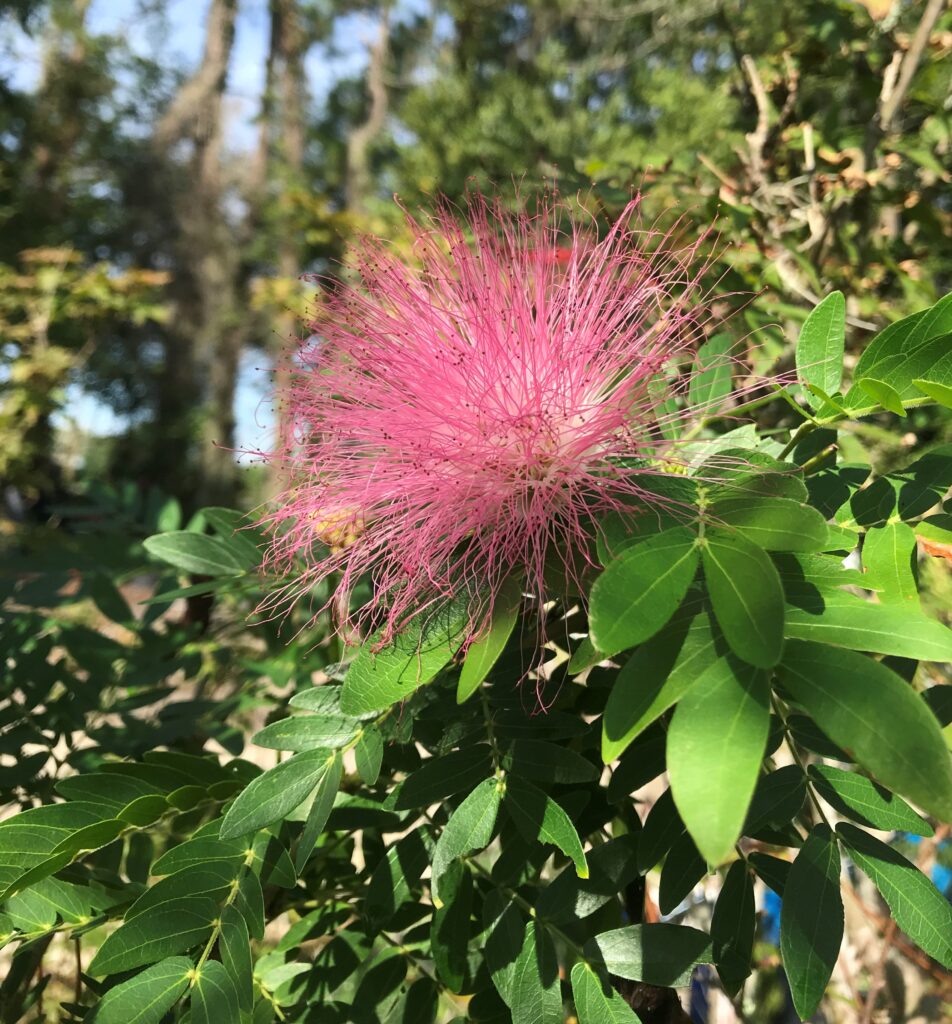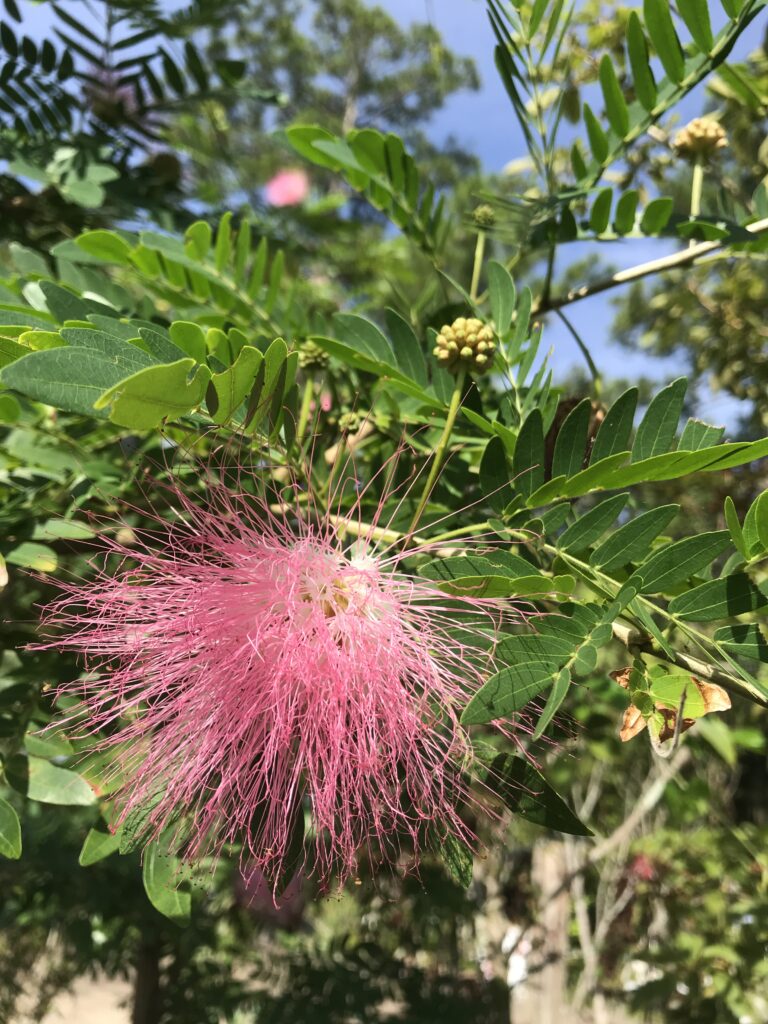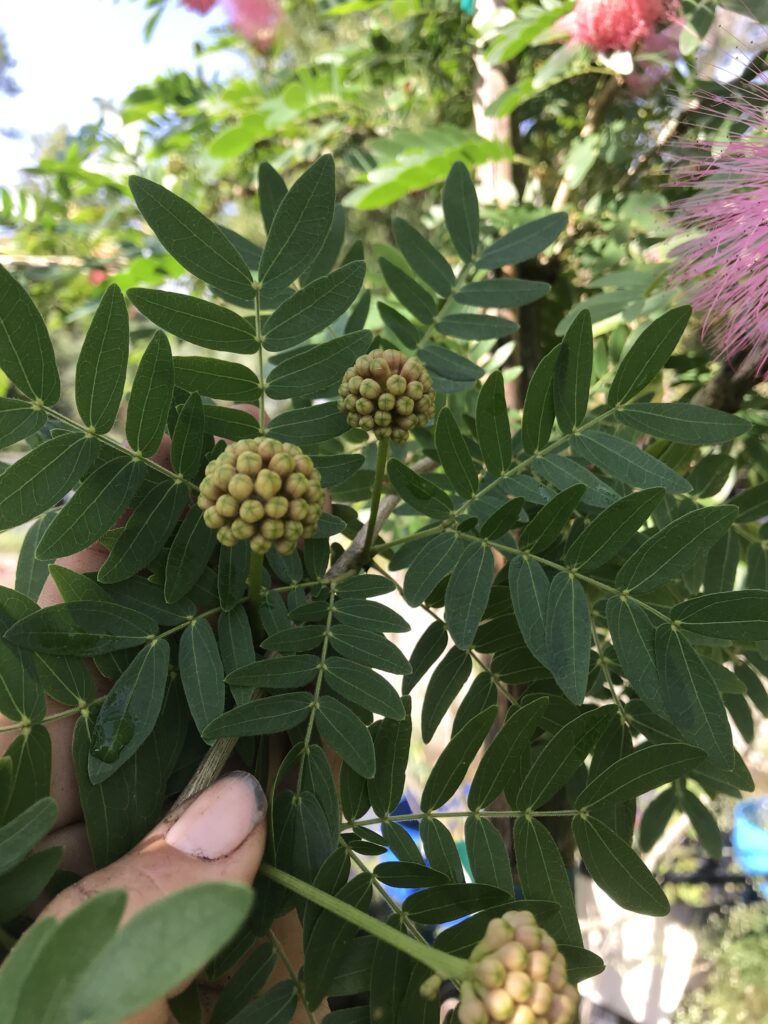S & J Nursery’s Guide to Growing
Rainbow Pink Powder Puff
in the Northeast Florida Landscape
( Calliandra surinamensis )
Rainbow Powder Puff Calliandra surinamensis Origins:

Native to South America Calliandra surinamensis is a shrubby semi-evergreen plant that is cold hardy to 32 degrees degrees. They can be planted in zones 9-11, and are root hardy in zone 9 ( winter damaged plants from hard freezes will regrow from the ground) and folaige hardy in zones 10-11. You can expect some damage to foliage and flowers when temperatures are in the low 30s so cover them or let them go and trim off damaged stems for quick recovery in the spring when all danger of frost has passed.
Sun Exposure for the Rainbow Pink Powder Puff:
– Pink rainbow powder puff plants are tolerant of full sun and partial shade situations in the Northeast Florida landscape and do equally well in both areas.
In Northeast Florida, a plant receiving 6 hours or more of sun exposure is considered to be planted in a full sun location. Morning shade and afternoon sun is also ideal, or filtered light under taller growing shade trees. Plants will bloom less in lower light areas but may be better protected from damaging winter frosts in those same shadier locations.
– Best if planted on the south side of the house away from cold north winds,
up next to a fence or near the foundation of a home or other building, or near larger shade trees that will protect these tropical plants from frost. Or plant on the west side of a home or building.
Foliage of the Rainbow Pink Powder Puff:
– Bright medium green semi evergreen foliage depending on winter temperatures. Foliage may remain evergreen or may go dormant in our Northeast Florida area gardens. But will quickly regrow from its roots or stems the following spring in the Jacksonville and St. Augustine area gardens.
– As with all tropical plantings, they are particularly responsive to their individual planting location. When planted on the south side of the house away from north winds, or where receiving some frost protection from larger trees or nearby buildings. you may get only foliar damage. If planted into open exposed areas in full sun you may get leaf and stem damage. If in a protected area you may get no damage at all. Utilize your yards frost free microclimates for all of your tropical plant selections.

Soil Preference / Salt tolerance of the Rainbow Pink Powder Puff / Calliandra surinamensis:
– powder puff plants are at home in our Northeast Florida’s sandy soils but will still benefit from soil amendment at planting time. Amend the soil when planting with compost to help your Jacksonville and St. Augustine area soil hold both water and nutrients and keep your cestrum plants healthy and blooming.
– Salt tolerance unknown
Size Variance of Rainbow Pink Powder Puff / Calliandra surinamensis:
– The foliage on the Rainbow Pink Powder Puff / Calliandra surinamensis plant can reach heights of 10-15 ft ft in height and 10-15 ft in width . Although these plants respond well to harsh prunings allowing them to be utilized as hedges, they make a stunning ornamental flowering tree.
Growth Habit Rainbow Pink Powder Puff / Calliandra surinamensis Plants:
– Upright vase shaped growth habit
– Responds well to pruning so the shape may be altered to suit easily.
Growth Rate Rainbow Pink Powder Puff / Calliandra surinamensis Plant:
– Fast growing, expect 1-3 ft of growth in a single growing season once your plants are established into the landscape.
Blooms of the Rainbow Pink Powder Puff / Calliandra surinamensis:
– Blooms during summer are really quite a site to see. the stamens of the flower stick out in all directions and are soft pink with white underneath, very similar to the invasive mimosa tree in appearance.
Water Requirements of the Rainbow Pink Powder Puff / Calliandra surinamensis:
– Although much more durable once established in the landscape, regular water is necessary to get the plant rooted and growing on its own after being planted in the ground from an S & J Nursery container.
I have successfully grown these plants in both shaded areas with soil that stays continuously moist and in sandy soils in higher light locations, for me these are not picky about soils conditions.
Best Uses For Rainbow Pink Powder Puff / Calliandra surinamensis in the Jacksonville | St. Augustine Area Landscapes :
– Great as an ornamental flowering tree for a smaller scale tree that doesnt shade out the entire lawn.
– can be used in hedge screen, if kept pruned.
– Attracts pollinators to the garden

Care of Rainbow Powder Puff Plants in the Northeast Florida Landscape:
– Amend sandy soils generously with compost to help your Rainbow Pink Powder Puff plants get the much needed water and nutrients it takes to feed these heavy blooming beauties.
Here is a link to S & J Tree Farm and Nurseries Guide to Planting Your Plants in their New Home
– Water every day during the establishment period after planting in the garden from an S & J Nursery container. Be sure to continue supplemental irrigation during the hot summer months during prolonged droughts. Here is a link for S & J Tree Farm and Nurserys information on how to water your newly installed plantings in the Northeast Florida landscape
– Fertilize each year just after trimming in the spring with a good shovel full
of garden compost or use Osmocote or another slow release plant food spring, summer and fall.
– When temperatures drop into the 25-32 degrees you may opt to protect your foliage and or stems from severe frost damage by throwing a blanket or other breathable fabric over the top of the plant making sure the edges touch the ground to trap in the heat from the soil.
– Make your last summer pruning in August giving your Powder Puff plant ample time to recover new foliage that will harden off before winter arrives for us here in late December. Pruning too late into the fall will cause flushes of cold sensitive new growth that is sure to freeze during even a light frost that hardened off foliage would not be affected by.
– DO NOT REMOVE WINTER BURNT FOLIAGE UNTIL ALL DANGER OF FROST HAS PASSED. Be sure not to remove any stems or leaves from the plant until we have reached the last average frost date and there are no late freezes being predicted. ( mid February for Northeast Florida is the average last frost date) Trimming burnt foliage and stems before then will leave bare branches deeper on the plant exposed to cold temperatures that would have been protected by those same stems and foliage if left unpruned and most often results in loss of the plant entirely.

